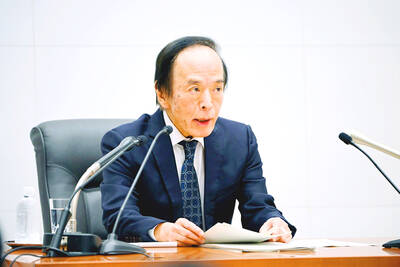Japan’s All Nippon Airways (ANA) yesterday said a modified Dreamliner had experienced a fault earlier this month, but insisted it would not affect the restart of the high-tech planes.
A company spokeswoman said discoloring on an electrical panel had been caused by vibrations from an insufficiently tightened nut during the flight on May 4, but added the incident was not connected to previous battery issues.
“The problem occurred in one particular airplane alone, and we have already fixed the trouble,” the spokeswoman said. “We believe the incident will not affect the safety of 787 flights.”
The incident, which ANA characterized as “minor,” is the first fault to be reported since regulators gave the green light to Boeing to get its next-generation aircraft back in the skies after a months-long hiatus.
Dreamliners worldwide were grounded after two separate incidents on Japanese-owned planes involving overheating in the lithium-ion battery packs in January, one of which provoked a fire on a parked plane in Boston.
After months of investigations into the plane’s power packs, US authorities last month issued formal approval of Boeing’s battery fix, followed by a similar move from Japanese regulators.
ANA said there had been no risk to the plane and it had landed normally after a “training flight” from Tokyo’s Haneda Airport to Chitose in the northern island of Hokkaido on May 4.
The airline, the single biggest customer of the lightweight plane, which operates around a third of the 50 that Boeing has delivered, said the glitch would not affect the resumption of flights planned for next month.

Taiwan’s long-term economic competitiveness will hinge not only on national champions like Taiwan Semiconductor Manufacturing Co. (TSMC, 台積電) but also on the widespread adoption of artificial intelligence (AI) and other emerging technologies, a US-based scholar has said. At a lecture in Taipei on Tuesday, Jeffrey Ding, assistant professor of political science at the George Washington University and author of "Technology and the Rise of Great Powers," argued that historical experience shows that general-purpose technologies (GPTs) — such as electricity, computers and now AI — shape long-term economic advantages through their diffusion across the broader economy. "What really matters is not who pioneers

In a high-security Shenzhen laboratory, Chinese scientists have built what Washington has spent years trying to prevent: a prototype of a machine capable of producing the cutting-edge semiconductor chips that power artificial intelligence (AI), smartphones and weapons central to Western military dominance, Reuters has learned. Completed early this year and undergoing testing, the prototype fills nearly an entire factory floor. It was built by a team of former engineers from Dutch semiconductor giant ASML who reverse-engineered the company’s extreme ultraviolet lithography (EUV) machines, according to two people with knowledge of the project. EUV machines sit at the heart of a technological Cold

TAIWAN VALUE CHAIN: Foxtron is to fully own Luxgen following the transaction and it plans to launch a new electric model, the Foxtron Bria, in Taiwan next year Yulon Motor Co (裕隆汽車) yesterday said that its board of directors approved the disposal of its electric vehicle (EV) unit, Luxgen Motor Co (納智捷汽車), to Foxtron Vehicle Technologies Co (鴻華先進) for NT$787.6 million (US$24.98 million). Foxtron, a half-half joint venture between Yulon affiliate Hua-Chuang Automobile Information Technical Center Co (華創車電) and Hon Hai Precision Industry Co (鴻海精密), expects to wrap up the deal in the first quarter of next year. Foxtron would fully own Luxgen following the transaction, including five car distributing companies, outlets and all employees. The deal is subject to the approval of the Fair Trade Commission, Foxtron said. “Foxtron will be

INFLATION CONSIDERATION: The BOJ governor said that it would ‘keep making appropriate decisions’ and would adjust depending on the economy and prices The Bank of Japan (BOJ) yesterday raised its benchmark interest rate to the highest in 30 years and said more increases are in the pipeline if conditions allow, in a sign of growing conviction that it can attain the stable inflation target it has pursued for more than a decade. Bank of Japan Governor Kazuo Ueda’s policy board increased the rate by 0.2 percentage points to 0.75 percent, in a unanimous decision, the bank said in a statement. The central bank cited the rising likelihood of its economic outlook being realized. The rate change was expected by all 50 economists surveyed by Bloomberg. The